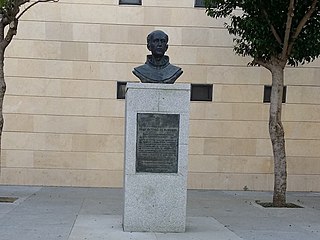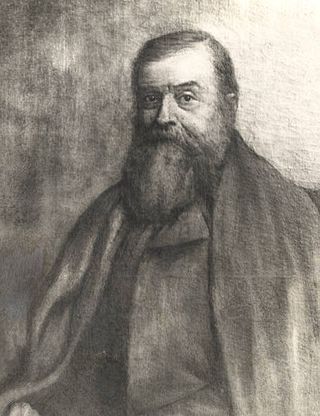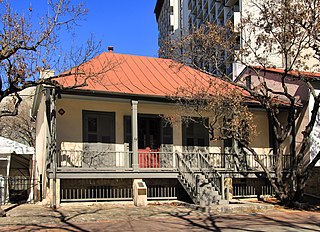
The Spanish Governor's Palace is a historic adobe from the Spanish Texas period located in Downtown San Antonio.

The Presidio Nuestra Señora de Loreto de la Bahía, known more commonly as Presidio La Bahía, or simply La Bahía is a fort constructed by the Spanish Army that became the nucleus of the modern-day city of Goliad, Texas, United States. The current location dates to 1747.

Main and Military Plazas Historic District is a historic district in San Antonio, Texas. It was listed on the National Register of Historic Places in 1979, with a boundary increase in 2019.

San Pedro Springs Park is located in the Bexar County city of San Antonio in the U.S. state of Texas. Surrounding the source of the springs, the 46-acre park is the oldest in the state of Texas. It is the location of a Payaya Indian village known as Yanaguana, and is the original site of the city of San Antonio. The park is alternately known as San Pedro Park. The park was designated a Recorded Texas Historic Landmark in 1965. It was added to the National Register of Historic Places listings in Bexar County, Texas on November 1, 1979.

The City of San Antonio is one of the oldest Spanish settlements in Texas and was, for decades, its largest city. Before Spanish colonization, the site was occupied for thousands of years by varying cultures of indigenous peoples. The historic Payaya Indians were likely those who encountered the first Europeans.

Antonio de San Buenaventura y Olivares or simply Fray Antonio de Olivares was a Spanish Franciscan who officiated at the first Catholic Mass celebrated in Texas, and he was known for contributing to the founding of San Antonio and to the prior exploration of the area. He founded, among other missions, the Alamo Mission in San Antonio, the Presidio San Antonio de Bexar, and the Acequia Madre de Valero.

Ferdinand Ludwig Herff (1820–1912) was a 19th-century German-born physician who emigrated to Texas and became a medical pioneer in San Antonio. He was one of the co-founders of the Bettina commune. In 1982, Recorded Texas Historic Landmark 1268 was placed on Malakopf Mountain in Boerne, to honor Herff. His homesite in San Antonio was designated a Recorded Texas Historic Landmark in the year 2000, Marker number 12345.

Presidio de Béxar was a Spanish fort built near the San Antonio River, located in what is now San Antonio, Texas, in the United States. It was designed for protection of the mission San Antonio de Valero and the Villa de Béjar. The Presidio de Béxar was founded on May 5, 1718 by Spanish colonial official Martín de Alarcón and his party of thirty-five soldiers. The Villa de Béjar is known for being the first Spanish settlement of San Antonio and consisted of the families of the Presidio Soldiers and those of the prior expeditions. It also served to secure Spain's claim to the region against possible encroachment from other European powers.

Alfred Giles was a British architect who emigrated to the United States in 1873 at the age of 20. Many of the private homes and public buildings designed by Giles are on the National Register of Historic Places and have been designated Recorded Texas Historic Landmarks. Based in San Antonio, his buildings can be found predominantly in south Texas and northern Mexico. Giles is credited with "a profound influence on architecture in San Antonio."

The Carl Wilhelm August Groos House is located in the Bexar County city of San Antonio in the U.S. state of Texas. It was designated a Recorded Texas Historic Landmark in 1977. Designed by Alfred Giles in 1880, the building contractor was John H. Kampmann. Giles used a Victorian Gothic Revival on this limestone home. Groos had immigrated from Germany to Texas in 1848, at which time he and his brothers started a freighting firm. In 1871, he built the Carl W. A. Groos House in New Braunfels. In 1872, he and his family settled in San Antonio. Groos married Hulda Amalie Moureau and became a founding member of the Groos National Bank. In 1880, Groos hired Giles to build his San Antonio home. It is listed on the National Register of Historic Places listings in Bexar County, Texas as a contributing structure of the King William Historic District. Groos died in 1893. In 1957, the house was purchased by the San Antonio Council of the Girl Scouts of the USA. The Girl Scouts sold the home to Charles Butt. It has been restored and is in private ownership.

The Guenther House is a restaurant, museum and store located at 205 E. Guenther Street in the King William neighborhood of the Bexar County city of San Antonio in the U.S. state of Texas. Currently operated by C. H. Guenther and Son. Inc., the home was originally built as a private residence in 1859 by Pioneer Flour Mills founder Carl Hilmar Guenther. It was listed on the National Register of Historic Places listings in Bexar County, Texas on October 11, 1990.

Casa Navarro is a historic site in San Antonio, Bexar County, in the U.S. state of Texas. The original house complex was the residence of Texas patriot José Antonio Navarro (1795–1871), a rancher, merchant, leading advocate for Tejano rights, and one of only two native-born Texans to sign the Texas Declaration of Independence. Navarro first bought the property, about 1.5 acres, in 1832. The limestone, caliche block, and adobe structures were built c. 1832–1855, and Navarro moved onto the property soon after.

The Conservation Society of San Antonio is located in the Bexar County city of San Antonio in the U.S. state of Texas. Founding members were Emily Edwards, who became the organization's first president, and Rena Maverick Green. The organization was formed on March 22, 1924, and officially incorporated on July 8, 1925. The Society is currently headquartered in the Anton Wulff House, which they saved from destruction in 1974. The home was built 1869–1870 by German immigrant Anton Wulff, who became the city's first Park Commissioner.

The Edward Steves Homestead is located in the Bexar County city of San Antonio in the U.S. state of Texas. It was designed by architect Alfred Giles and designated a Recorded Texas Historic Landmark. The main house was donated to the San Antonio Conservation Society in 1952. The organization completely restored the main house as a museum, and now conducts daily tours. The complete homestead property consists of four individual structures: the main house museum, the carriage house, the river house, and the servants' quarters. It is listed on the National Register of Historic Places listings in Bexar County, Texas, as a contributing structure of the King William Historic District.

The Jeremiah Dashiell House is located in the Bexar County city of San Antonio in the U.S. state of Texas. Also known as Casa Villita, it was designated a Recorded Texas Historic Landmark under that name in 1962. It is listed on the National Register of Historic Places listings in Bexar County, Texas as a contributing structure of the La Villita Historic District.

The Yturri–Edmunds Historic Site is a historic site in San Antonio, Texas. The house is listed on the National Register of Historic Places listings in Bexar County, Texas. The homestead and mill were designated a Recorded Texas Historic Landmark in 1966.

The Johann and Anna Heidgen House is located in the Bexar County city of San Antonio in the U.S. state of Texas. It is listed on the National Register of Historic Places listings in Bexar County, Texas. The structure was designated a Recorded Texas Historic Landmark in 2003. It is also known as the Heidgen-Zilker House. The house was built circa 1882 and has been used for a variety of purposes, including as a residence, as a youth organization facility, attorney's office, wedding venue, and at one time as a restaurant.

The Woman's Club of San Antonio is a philanthropic civic organization located in Bexar County in the U.S. state of Texas. It was founded October 1, 1898 by Mary Eleanor Brackenridge, Marin B. Fenwick and sixteen other individuals who had been inspired by the National Federation of Women's Clubs. Brackenridge served as the organization's first president. The sororal organization is the oldest civic organization in San Antonio. They partner with businesses, local government and other civic organizations to promote health, safety, welfare and education. One of its original goals was to bring the 19th Amendment to the United States Constitution to fruition, and was the first Texas woman's club to promote the issue.

The San Antonio Municipal Auditorium was a building located at 100 Auditorium Circle, San Antonio, Texas. It was built as a memorial to American soldiers killed in World War I.
The King William Historic District of San Antonio, Texas was listed on the National Register of Historic Places listings in Bexar County, Texas on January 20, 1972. The area was originally used as farm acreage by the Spanish priests of the Misión San Antonio de Valero, and eventually parceled off for the local indigenous peoples of the area. In addition to residential homes, the district also includes the King William Park and Bandstand originally built in 1892 on the arsenal grounds, and later moved to its current location. Other features are the Upper Mill Park, the King William River Walk, and the Johnson Street pedestrian bridge.






















